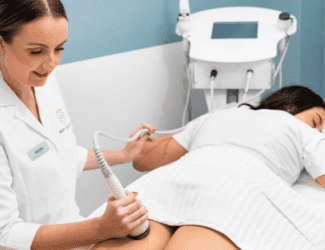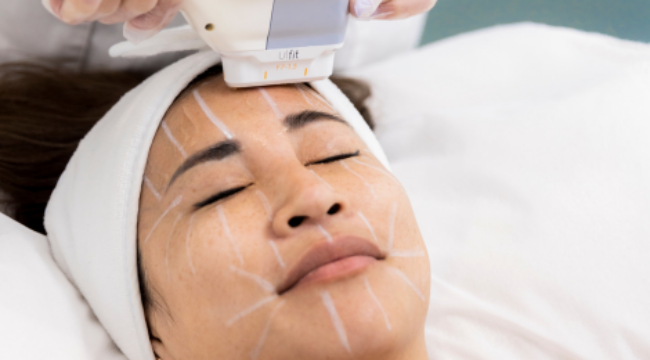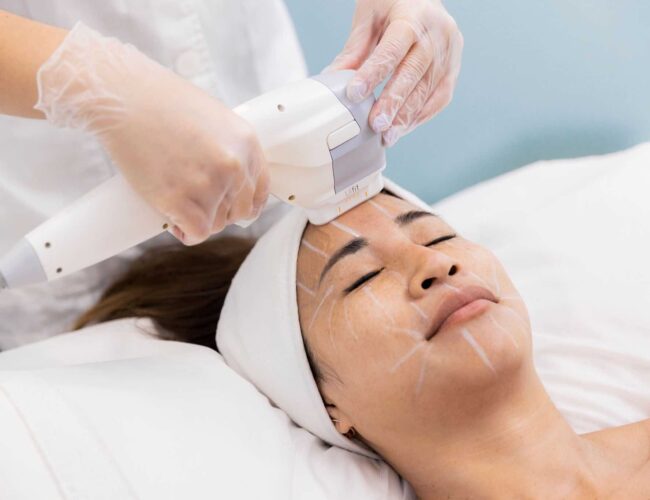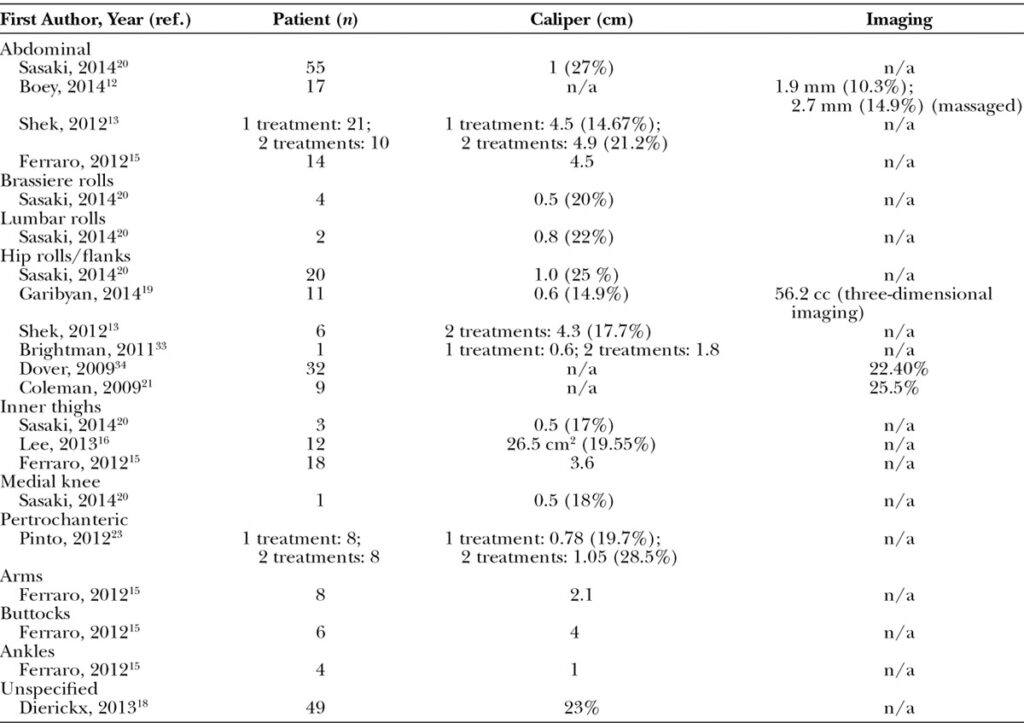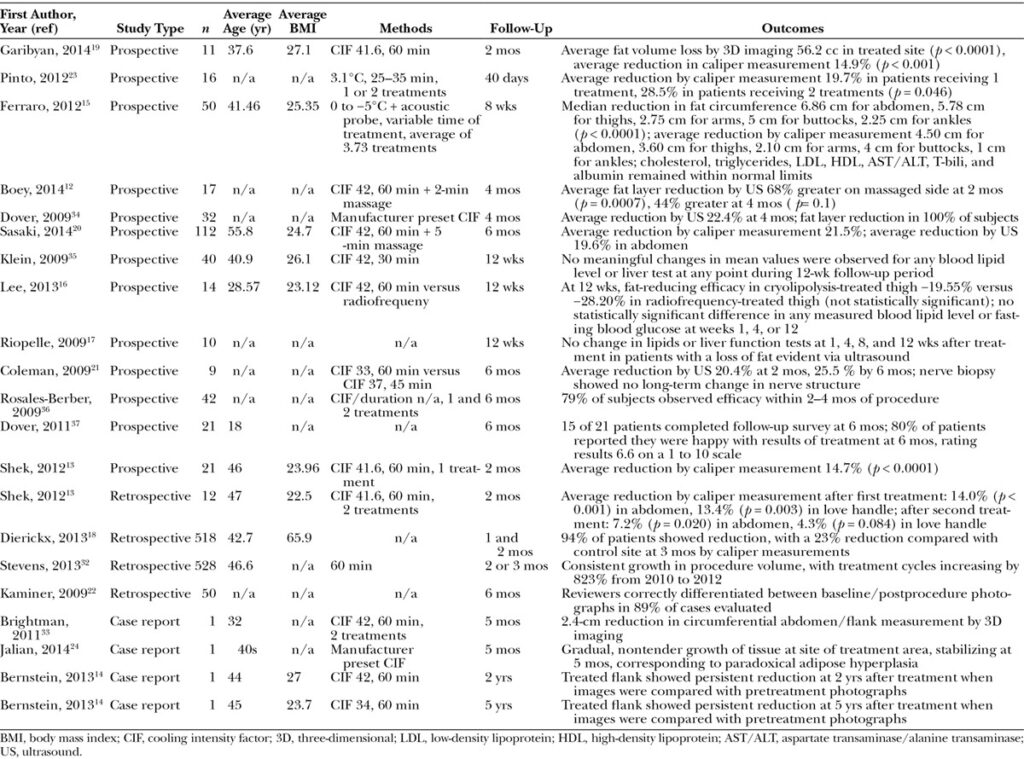Background:
Cryolipolysis is a nonsurgical technique for localized fat reduction. With the increased risk of complications from more invasive methods such as liposuction, cryolipolysis presents a promising method for nonsurgical body contouring. This study presents a systematic review of the available clinical data, with an emphasis on the efficacy, methods, safety, and complications of cryolipolysis.
Methods:
To identify clinical studies that assessed outcomes of cryolipolysis, a systematic review of the MEDLINE and Cochrane databases was performed with the search algorithm cryolipolysis OR cool sculpting OR fat freezing OR lipocryolysis.
Results:
The primary literature search returned 319 articles. After inclusion criteria were applied and additional articles were idenfied via manual review of article references, 19 studies were selected for review. Average reduction in caliper measurement ranged from 14.67 percent to 28.5 percent. Average reduction by ultrasound ranged from 10.3 percent to 25.5 percent. No significant impact on lipid levels or liver function tests after cryolipolysis treatments was noted in any study. Only mild, short-term side effects, such as erythema, swelling, and pain, were noted. Paradoxical adipose hyperplasia was described in one patient.
Conclusions:
Cryolipolysis is a promising procedure for nonsurgical fat reduction and body contouring and presents a compelling alternative to liposuction and other, more invasive methods. This procedure appears to be safe in the short term, with a limited side effect profile, and results in significant fat reduction when used for localized adiposities. It remains unclear whether posttreatment manual massage and multiple treatments in the same anatomic area enhance the efficacy of cryolipolysis.
Body contouring remains among the most common cosmetic surgical procedures performed in the United States. Data from the American Society for Aesthetic Plastic Surgery indicate that liposuction replaced breast augmentation as the most popular surgical procedure in 2013, with 363,912 procedures performed. Its popularity has grown considerably because of advantages such as aesthetic improvements as well as numerous metabolic benefits.1,2 Despite its popularity, there remain rare but significant risks regarding liposuction, including complications from anesthesia, infections, and even death.3 Clinical studies have reported a 21.7 percent incidence of minor complications as well as a 0.38 percent incidence of major complications.4,5 Similarly, Fischer et al. showed that the incidence of minor wound complications was 6.3 percent, and the incidence of a major morbidity was 6.8 percent within 30 days after a surgical body contouring procedure.6
Although liposuction is an effective therapeutic option for the removal of excess adipose tissue, it remains an invasive procedure and carries the inherent risks associated with surgery. In recent years, new modalities have been developed to address body contouring from a less-invasive perspective. These modalities primarily target the physical properties of fat that differentiate it from the overlying epidermis and dermis, thus resulting in selective destruction of fat. Devices using high-frequency ultrasound, radiofrequency energy, and laser light have the potential to improve efficiency, minimize adverse consequences, and shorten postoperative recovery time. Through thermal destruction, cavitational destruction, or creation of a temporary adipocyte cell membrane pore, the final result is that the number of adipocytes is reduced, which, when translated over millions of fat cells, results in a measurable reduction of fat.7
Cryolipolysis is one of the most recent forms of noninvasive fat reduction to emerge. The development behind cryolipolysis stems from the clinical observation of cold-induced panniculitis.8–10 In 1970, Epstein and Oren coined the term popsicle panniculitis after reporting the presence of a red indurated nodule followed by transient fat necrosis in the cheek of an infant who had been sucking on a popsicle.9 Initially described in infants, cold-induced panniculitis has also been observed in adult patients. These observations led to the concept that lipid-rich tissues are more susceptible to cold injury than the surrounding water-rich tissue. With these historical observations in mind, Manstein et al. introduced a novel noninvasive method for fat reduction with freezing in 2007, termed cryolipolysis.11 This technique is performed by applying an applicator to the targeted area set at a specific cooling temperature for a preset period of time. This targets adipocytes while sparing the skin, nerves, vessels, and muscles.
Initial preclinical and clinical studies have demonstrated the efficacy of cryolipolysis for subcutaneous fat layer reduction. However, the exact mechanism of action for cryolipolysis is not yet completely understood. In addition, the techniques of cryolipolysis treatment are not uniformly applied. Studies have suggested that the addition of posttreatment manual massage may enhance the effectiveness of a single cryolipolysis treatment, and that multiple treatments may lead to further improvement.12,13 Finally, we are currently still unaware of the long-term side effects and outcomes of this treatment. The aim of the present review was to give an overview of cryolipolysis with emphasis on the efficacy (volume reduction), methods, safety, and complications.
Recently, a surge of novel technologies involving noninvasive, energy-based techniques have been introduced to the market, signaling a potential paradigm shift in fat reduction and body contouring practices. The major goal of these novel therapies includes volume reduction of tissue, with a possible end point of noninvasive body contouring.25 With more than 450,000 procedures performed thus far, cryolipolysis is becoming one of the most popular alternatives to liposuction for spot reduction of adipose tissue.26 Because of its ease of use and limited adverse effects, this procedure is becoming the leading technology in noninvasive techniques as well. This review sought to explore the efficacy, methods, safety, and complications of cryolipolysis in the current literature.
Although its mechanism is not fully understood, it is believed that vacuum suction with regulated heat extraction impedes blood flow and induces crystallization of the targeted adipose tissue when cryolipolysis is performed.11,27 The temperatures induced in cryolipolysis have no permanent effect on the overlying dermis and epidermis. However, this cold ischemic injury may promote cellular injury in adipose tissue via cellular edema, reduced Na-K-ATPase activity, reduced adenosine triphosphate, elevated lactic acid levels, and mitochondrial free radical release.20 Another mechanism proposes that the initial insult of crystallization and cold ischemic injury induced by cryolipolysis is further compounded by ischemia reperfusion injury, causing generation of reactive oxygen species, elevation of cytosolic calcium levels, and activation of apoptotic pathways.20 Ultimately, crystallization and cold ischemic injury of the targeted adipocytes induce apoptosis of these cells and a pronounced inflammatory response, resulting in their eventual removal from the treatment site within the following several weeks.7,11,25 Histological studies show that within 3 months, macrophages are mostly responsible for clearing the damaged cells and debris.26,28
With the removal of the adipocytes internally, there has been concern that cryolipolysis may cause rising blood lipid levels and elevations in liver enzymes that may put the patient at additional risk, particularly for cardiovascular parameters. However, multiple studies have demonstrated that cholesterol, triglycerides, low-density lipoprotein, high-density lipoprotein, aspartate transaminase/alanine transaminase, total bilirubin, albumin, and glucose remained within normal limits during and after cryolipolysis.15–17
With the relatively recent emergence of cryolipolysis, many factors still need to be considered and investigated, including what type of patient would benefit most from this procedure. Ferraro et al. suggested that patients who require only small or moderate amounts of adipose tissue and cellulite removal would benefit most from cryolipolysis treatment.15 Contraindications to cryolipolysis include cold-induced conditions such as cryoglobulinemia, cold urticaria, and paroxysmal cold hemoglobinuria.29 Cryolipolysis should not be performed in treatment areas with severe varicose veins, dermatitis, or other cutaneous lesions.23,27
Although all studies reviewed showed a fat reduction in every area examined, it is still unknown what areas are most responsive to cryolipolysis. Various factors may play a role in the degree of fat reduction observed after cryolipolysis. The vascularity, local cytoarchitecture, and metabolic activity of the specific fat depots in question may play a role. Because of the limited size and number of studies evaluating cryolipolysis in clinical populations, it is unclear which treatment sites are most amenable to cryolipolysis. Future comparative outcome studies should be adequately powered to determine which treatment sites are most suitable for fat reduction with this modality.
Because cryolipolysis is still a relatively new procedure, treatment protocols have yet to be optimized to maximize results. Recent studies have focused on maximizing the reduction of adipose tissue by adjusting treatment protocols. Three studies assessed the theoretical enhanced efficacy with multiple treatments in the same anatomic area and demonstrated that a second successive course of cryolipolysis treatment led to further fat reduction.13,23 It is important to note that although a subsequent treatment leads to further fat reduction, the extent of improvement was not as dramatic as the first treatment. Interestingly, one study demonstrated that a second treatment enhanced fat layer reduction in the abdomen area but not the love handles.13 One hypothesis for the diminished effect of the second treatment may be that the fat exposed to the second heat extraction is closer to the muscle layer. The vascular supply to the muscle layer may impede the efficiency of heat extraction so that the fat closer to the muscle layer may not reach the intended optimal temperature of 4°C. Another hypothesis is that adipocytes that survived the first treatment have a higher tolerance to cold.
Boey and Wasilenchuk evaluated whether the addition of a posttreatment manual massage enhanced the efficacy of a single cryolipolysis treatment.12 Immediately after treatment, patients received a 2-minute manual massage. This consisted of 1 minute of vigorous kneading of the treated tissue between the thumb and fingers followed by 1 minute of circular massage of the treated tissue against the patient’s body. To examine the effects of massage on subcutaneous tissue over time, histological analysis was completed through 4 months after treatment. Although the difference at 2 months after treatment was statistically significant, the difference at 4 months after treatment was not. One hypothesis for potentially improved efficacy with manual massage is that manual massage caused an additional mechanism of damage to the targeted adipose tissue immediately after treatment, perhaps from tissue-reperfusion injury. Histological analysis revealed no evidence of necrosis or fibrosis resulting from the massage, thus showing posttreatment manual massage to be a safe and effective method to further reduce the fat layer after cryolipolysis. Sasaki et al. described cryolipolysis with 5 minutes of posttreatment integrated preset mechanical massage using the device applicator with excellent outcomes.20
A low profile of adverse effects is one of the main advantages with cryolipolysis, especially when compared with more invasive measures. Only mild, short-term side effects, such as erythema, bruising, changes in sensation, and pain, were reported in the studies reviewed. Erythema was noted in multiple studies immediately after the treatment and subsided within a week.18–20 This is most likely because of the strength of the vacuum and the temperature at which the tissue is kept for extended durations and poses no threat to the patients. Swelling and bruising of the area were shown to a slightly lesser extent than erythema, but are believed to be because of the same processes. These complications also subsided shortly after.13,16,18,19 Hypersensitivity and hyposensitivity were shown in studies but were never debilitating nor persisted beyond 1 month. Coleman et al. demonstrated that patients exhibiting reduction in sensation recovered normal sensation in 3.6 weeks.21 This study also showed that a nerve biopsy taken at 3 months after treatment showed no long-term changes to nerve fibers, concluding that temperature and duration of cryolipolysis have no permanent effect on nervous tissue.21 In one study, pain during the procedure was generally nonexistent to tolerable 96 percent of the time.18
Rare side effects that have been described include vasovagal reaction18 and paradoxical adipose hyperplasia.24 Jalian et al. estimated an incidence of 0.0051 percent, or approximately one in 20,000, for paradoxical adipose hyperplasia.24 Affected patients exhibit fat loss after therapy and then develop a large, demarcated, tender fat mass at the site 2 to 3 months later. The hypothesized pathogenesis includes recruitment of stem cells and hypertrophy of existing fat cells in the area.24 However, compared with traditional liposuction side effects, cryolipolysis poses a minor threat to patients, with a very low incidence of complications.
Of note, the reviewed studies used a variety of different modalities to determine the degree of fat reduction after cryolipolysis treatments. Various studies have compared caliper, ultrasound, three-dimensional imaging, and manual tape measurements. Although no single study has compared all of these modalities, the available data suggest that these techniques correlate well with one another.30,31 Studies that used more than one of these modalities to assess outcomes after cryolipolysis also demonstrated that these measurements corresponded well.19,20
A drawback of this work is the limited number of high-quality, prospective, randomized clinical studies. Cryolipolysis was first described in 2007, and although its popularity has increased dramatically, the available literature remains limited. Tremendous variability exists in study design, machinery used, and outcome measures. Because of this lack of uniformity, comparing effect size becomes challenging, and the value of a meta-analysis of the available data is limited. The variations in the available studies make it difficult to control for any bias present in the discussed studies. Despite these limitations, clinical data demonstrate consistent fat reduction in treated subjects, which supports the clinical utility of this technique.

